
The Battle of Fallen Timbers was the final battle of the Northwest Indian War,a struggle between Native American tribes affiliated with the Northwestern Confederacy and their British allies,against the nascent United States for control of the Northwest Territory. The battle took place amid trees toppled by a tornado near the Maumee River in northwestern Ohio at the site of the present-day city of Maumee,Ohio.

Lord Dunmore's War,also known as Dunmore's War,was a brief conflict in fall 1774 between the British Colony of Virginia and the Shawnee and Mingo in the trans-Appalachian region of the colony south of the Ohio River. Broadly,the war included events between May and October 1774. The governor of Virginia during the conflict was John Murray,4th Earl of Dunmore,who in May 1774,asked the House of Burgesses to declare a state of war with the Indians and call out the Virginia militia.
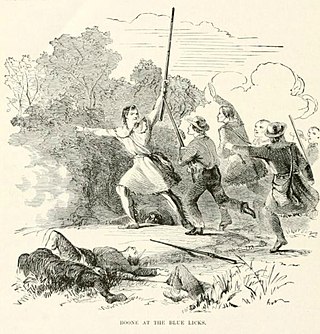
The Battle of Blue Licks,fought on August 19,1782,was one of the last battles of the American Revolutionary War. The battle occurred ten months after Lord Cornwallis's surrender at Yorktown,which had effectively ended the war in the east. On a hill next to the Licking River in what is now Robertson County,Kentucky,a force of about 50 Loyalists along with 300 indigenous warriors ambushed and routed 182 Kentucky militiamen,who were partially led by Daniel Boone,the famed frontiersman. It was the last victory for the Loyalists and natives during the frontier war. British,Loyalist and Native forces would engage in fighting with American forces once more the following month in Wheeling,West Virginia,during the Siege of Fort Henry.
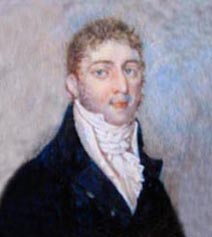
Francis Perceval Eliot was an English soldier,auditor,and man of letters. In 1814 he succeeded his half-brother as Count Eliot,however he did not feel it was proper to assume the title.
Major-General Sir Francis de Rottenburg,baron de Rottenburg was a military officer and colonial administrator who served in the armies of the Kingdom of France and later the United Kingdom.
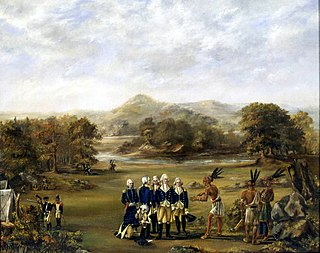
The Northwest Indian War (1785–1795),also known by other names,was an armed conflict for control of the Northwest Territory fought between the United States and a united group of Native American nations known today as the Northwestern Confederacy. The United States Army considers it the first of the American Indian Wars.

The western theater of the American Revolutionary War (1775–1783) was the area of conflict west of the Appalachian Mountains,the region which became the Northwest Territory of the United States as well as what would become the states of Arkansas,Kentucky,Louisiana,Missouri,and Tennessee. The western war was fought between American Indians with their British allies in Detroit,and American settlers south and east of the Ohio River,and also the Spanish as allies of the latter.
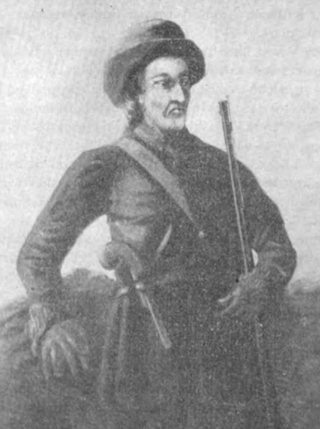
Simon Girty also known by his Seneca Nation name,Katepacomen,or "Renegade Girty" was a Pennsylvania-born loyalist and white chief of several tribes within the Shawnee-Iroquoian nations between the period of 1777 - 1812,and slave owner. Girty is most well known for overseeing the brutal torture and murder of Col William Crawford in 1782,and serving as the chief of a Miami tribe whose band of 400 warriors killed Major James Fontaine,the son of General Charles Scott during General Josiah Harmar's campaign.
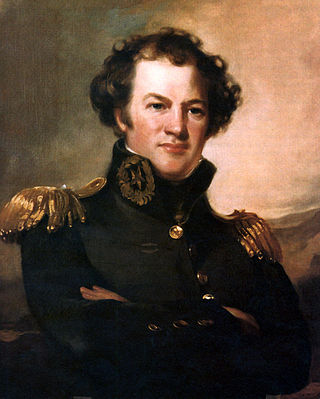
Alexander Macomb was the Commanding General of the United States Army from May 29,1828,until his death on June 25,1841. Macomb was the field commander at the Battle of Plattsburgh during the War of 1812 and,after the stunning victory,was lauded with praise and styled "The Hero of Plattsburgh" by some of the American press. He was promoted to Major General for his conduct,receiving both the Thanks of Congress and a Congressional Gold Medal.

Catecahassa or Black Hoof was the head civil chief of the Shawnee Indians in the Ohio Country of what became the United States. A member of the Mekoche division of the Shawnees,Black Hoof became known as a fierce warrior during the early wars between the Shawnee and encroaching American settlers. Black Hoof claimed to have been present at the Battle of the Monongahela in 1755 when General Edward Braddock was defeated during the French and Indian War,although there is no contemporary evidence that Shawnees took part in that battle.
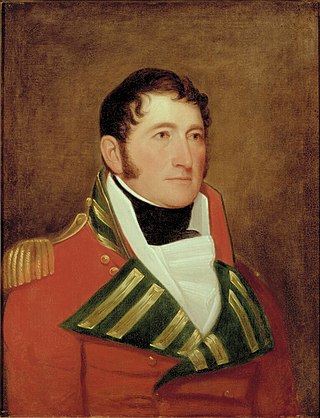
Lt.-Colonel William McKay is remembered for leading the Canadian Forces to victory at the Siege of Prairie du Chien during the War of 1812. After the war,he was appointed Superintendent of Indian Affairs at Drummond Island in what was then Upper Canada. Previous to the war,McKay was a noted fur trader who had travelled widely in Canada. He was a partner of the North West Company and a member of the Beaver Club at Montreal,Quebec. He was a brother of Alexander McKay,who accompanied Sir Alexander Mackenzie to the Pacific Ocean in 1793.
Matthew Elliott was an Irish-born Ulster-Scots merchant,farmer,colonial official,politician and military officer. He was active in British North America during and after the era of the American Revolution. Elliott held a key position in Anglo-Indian affairs during the time period.
Arthur Rankin was a surveyor,entrepreneur,militia officer,and political figure in Canada West.

The Crawford expedition,also known as the Sandusky expedition and Crawford's Defeat,was a 1782 campaign on the western front of the American Revolutionary War,and one of the final operations of the conflict. The campaign was led by Colonel William Crawford,a former officer in the U.S. Continental Army. Crawford's goal was to destroy enemy Native American towns along the Sandusky River in the Ohio Country,with the hope of ending Native attacks on American settlers. The expedition was one in a series of raids against enemy settlements that both sides had conducted throughout the war.

Lochry's Defeat,also known as the Lochry massacre,was a battle fought on August 24,1781,near present-day Aurora,Indiana,in the United States. The battle was part of the American Revolutionary War (1775–1783),which began as a conflict between Great Britain and the Thirteen Colonies before spreading to the western frontier,where American Indians entered the war as British allies. The battle was short and decisive:about one hundred Indians of local tribes led by Joseph Brant,a Mohawk military leader who was temporarily in the west,ambushed a similar number of Pennsylvania militiamen led by Archibald Lochry. Brant and his men killed or captured all of the Pennsylvanians without suffering any casualties.
From 1755 to 1830 Indian agent was a representative of the British Indian Department in British North America.
Alexander McKee was an American-born military officer and colonial official in the British Indian Department during the French and Indian War,the American Revolutionary War,and the Northwest Indian War. He achieved the rank of Deputy Superintendent General in 1794,the second highest position in the British Indian Department at the time.
Major Adam Charles Muir was an officer in the British Army,who played a significant but little-known role in the Anglo-American War of 1812.

The Indian Department was established in 1755 to oversee relations between the British Empire and the First Nations of North America. The imperial government ceded control of the Indian Department to the Province of Canada in 1860,thus setting the stage for the development of the present-day Department of Crown–Indigenous Relations and Northern Affairs Canada.
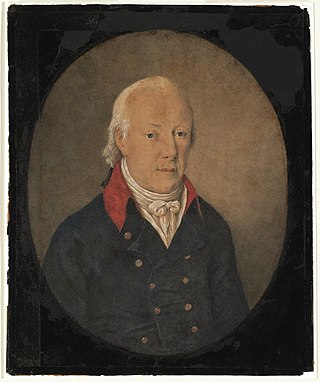
Colonel Daniel Robertson was an officer in the British Army in North America,commandant of the British post at Michilimackinac,and a landowner in Chatham Township,Canada. Born in Scotland,he first joined the 42nd Regiment of Foot,also known as the "Black Watch," and was present at the British capture of Montreal in 1760,as well as the invasion of Martinique in 1762. During the American Revolutionary War,he was an officer in the 84th Regiment of Foot,another regiment of Scots known as the Royal Highland Emigrants. In 1779,he was appointed commandant of Fort Osgewatchie and oversaw Native American raids on American settlements on the Mohawk River.














